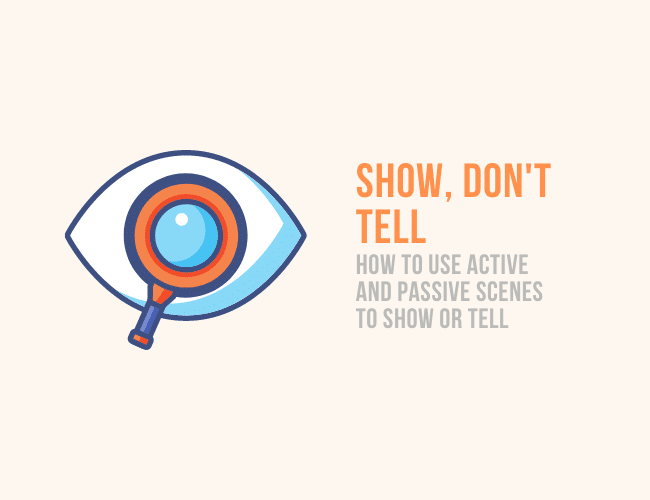We’ve all heard of passive vs. active sentences. Active sentences such as “three men stood by the gate” are more attractive and interesting than passive sentences such as “there were three men standing by the gate.”

But the concept of active vs. passive can also be applied to scenes within a story. Appropriate use of active and passive scenes can give your story an extra kick of life and can help with pacing as well.
What is an Active Scene?
An “active scene” can be understood as a form of “show don't tell” in writing. Rather than simply lay out events that occurred to your readers, bring the event to the present and make it happen in front of your readers instead. It’s the difference between telling someone a story and having them next to you, watching it happen.
Let’s take this scene:
Mr. Norton greeted the butcher in the morning. He does this every day, but the butcher, a rotund man in his late forties, did not seem to carry his usual sunny demeanor. Mr. Norton headed off to work and was left wondering what was wrong.
This scene is fine, but it’s about as interesting as listening to any story secondhand. It has little impact and can easily be glossed over as possibly unimportant, because it reads like an afterthought rather than an actual event.
To bring the reader into the scene, make the action happen in front of them:
“Morning, Ed,” Mr. Norton gave the man behind the meat counter his usual smile. After five years, their morning greetings had become something of a ritual.
“Ah, John.” Ed glanced up from his work. He wiped his large hands, thick with bacon grease, on the apron hanging over his round belly. “Morning.”
“How’s business?”
“Can’t complain,” Ed replied. But something was different. A dark cloud hung over the eyes of the usually cheerful man. He opened his mouth as if to say something else, but then turned away and busied himself with a haunch of beef. Mr. Norton hurried toward the station, but couldn’t help glancing back over his shoulder, wondering if something was bothering the meat monger.
When to Use Active and Passive Scenes
Active and Passive scenes both have their purpose and it’s important to know the appropriate times to use each.
Active scenes are best used for actual events that take place in the story and are necessary for moving the story forward. This is the time to apply the rule “show, don't tell” in your writing.
But if the event being mentioned is a “backstory” or only used to provide background information or character development, it’s better to use a passive scene. It's actually better here to tell and not show.
Example: How to Tell the Butcher's Story
Let’s take the scene with Mr. Norton and the butcher again. What is the significance of this scene?
If the butcher plays a significant role in the story, then the scene should be active.
Let’s say Mr. Norton is about to discover that a murder has occurred in his apartment building the night after he notices the butcher’s dark mood. He pieces together that the butcher was having an affair with the murder victim’s estranged wife. Not only that, the man had mentioned to Mr. Norton that he was possibly rekindling things with his ex. Now the butcher’s dark mood could suddenly indicate guilt over a murder, and the story hinges on Mr. Norton making the link and solving this crime.
The readers would definitely want to be shown, not told, about any and all interactions with the butcher.
But if the butcher is instead only “set dressing” or used to show some character aspect of Mr. Norton, then the scene would be better as passive.
Maybe the author wants to show that Mr. Norton is a caring person, or maybe on this particular day, he heads to work and notices that everyone around him appears to be in a dark mood, making the butcher just one of many. Or maybe a murder occurred but it has nothing to do with the butcher.
In this case, the reader doesn’t need to waste a lot of time reading about each interaction.
It is worth noting that the passive scene can also be used as a “red herring,” misleading the reader to think that the butcher has nothing to do with the murder by mentioning him in this brief manner, only to reveal later that he was the mastermind behind the crime after all. This method should be used carefully, as it could lead to the readers feeling like something’s missing from the main story arc or that important characters were underdeveloped.
A Time for Each
A good story makes use of both active and passive scenes. There are times to both show and tell in writing. Understanding where and how to use each will help you build a story that leads the readers through the most important turning points while providing background information with a soft touch.
Do you find yourself writing more active or passive scenes? Share below in the comments.
PRACTICE
To practice writing actively or passively, create a short scene and write it in both forms. Keep in mind the difference of Active = Show and Passive = Tell.
Need a prompt for your scene? Try this: Jess finds a wad of cash on the ground.
Take fifteen minutes to write. When you're done, share both versions in the comments below.
J. D. Edwin is a daydreamer and writer of fiction both long and short, usually in soft sci-fi or urban fantasy. Sign up for her newsletter for free articles on the writer life and updates on her novel, find her on Facebook and Twitter (@JDEdwinAuthor), or read one of her many short stories on Short Fiction Break literary magazine.



0 Comments